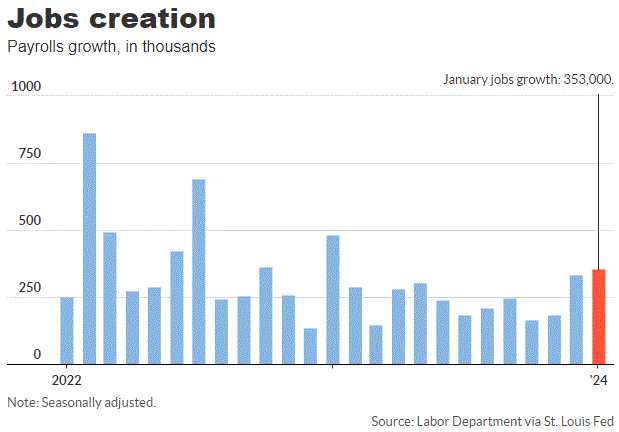The U.S. economy added a whopping 353,000 new jobs in January, but the surprisingly large gain may have been flattered by the adjustments the government makes to smooth out seasonal swings in employment.
Still, the increase in employment last month easily beat the market estimate and underscores the remarkable strength of the U.S. labor market.
Economists polled by The Wall Street Journal had forecast a 185,000 increase in new jobs.
The unemployment rate, meanwhile, stayed at 3.7% in January. It's near the lowest level since the 1960s.
The January jobs report is often hard to decipher because of big changes in the labor market at the start of each year. Temporary workers hired for the holiday shopping season are let go, for one thing, and many companies announced job cuts at that time.
The government tries to provide a more accurate picture of the labor market by using so-called seasonal adjustments to minimize the occasional large swing in employment.
But in recent years these adjustments have led to exaggerated job gains in January, economists say. The reported increase in new jobs in the month has topped 250,000 for six straight years.
Whatever the case, there’s no doubt the U.S. labor market is still quite strong. Hiring has slowed in the past year, to be sure, and layoffs might be creeping higher. But most Americans who want a job can find one.
The increase in employment in December, for example, was raised to 333,000 from an originally reported 216,000. That was another big surprise.
The sharp increase in wages over the past few years also tell the story. Businesses had to pay a lot more to retain and attract talent, especially after inflation spiked.
Hourly wages rose a a sharp 0.6% in January, the biggest increase in almost two years.
The increase in wages over the past year moved up to 4.5% from 4.3%, reversing a recent downtrend and leaving it still well above pre-pandemic levels.
The January jobs report, for all its strength, is unlikely to sway the Federal Reserve.
Central bank chief Jerome Powell said this week that an interest-rate reduction in March is highly unlikely.
The Fed wants to wait to see if inflation keeps cooling — along with the U.S. labor market — before taking the plunge. The strong January report will spur them to take a wait-and-see attitude.
Key details: Employment gains in January were dominated by health care, white-collar profession businesses and retails.
Health employment jumped 100,000. Professional jobs rose by 74,000. And retailers added 45,000 jobs.
Big picture: Businesses are still hiring and unemployment remains surprisingly low despite the highest interest rates in a few decades.
The strong labor market has insulated the U.S. from a recession, and if the Fed cuts interest rates this year as expected, the economy could improve enough to stoke more hiring.
The big worry for the Fed would be if a tight labor market kept upward pressure on wages and prevented inflation from slowing toward its 2% goal.
Inflation is now running around 3% year over year.
Looking ahead: “The U.S. labor market started 2024 with another strong jobs report,” said Eric Merlis, managing director and co-head of global markets at Citizens Bank.
“The U.S. economy is adding jobs at a fast clip, quelling fears of a recession, but also likely pushing the timing for a rate cut by the Fed farther out in the year, especially since the uptick in average hourly earnings may rekindle inflation concerns.”










